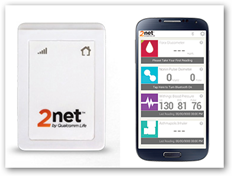Ok for all who want data from wearables and other mHealth apps and products, here’s a device and platform that will serve to gather all the information in the cloud. Every time a new gadget comes out this will save having to build yet one more communication platform. When you watch the video you will see some examples of technologies you may have already seen or read about, Withings scale for one. You also here some words from Kaiser Permanente give a short comment of support.
here’s a device and platform that will serve to gather all the information in the cloud. Every time a new gadget comes out this will save having to build yet one more communication platform. When you watch the video you will see some examples of technologies you may have already seen or read about, Withings scale for one. You also here some words from Kaiser Permanente give a short comment of support.
There are four gateways onto the 2net Platform’s data center:
- A standalone FDA-listed external device – the 2net Hub*
- An FDA-listed software module that connects mobile computing devices – 2net Mobile Core*
- Medical devices with an embedded cellular component
- Service platform integration between the FDA-listed 2net Platform to customer and technology partner service platforms using application programming interfaces (APIs)
* The 2net Platform, 2net Hub and 2net Mobile Core are separately FDA listed as Class I MDDS (Medical Device and Data Systems) in the U.S., Class I MDD and CE Registered in Europe, and Class I in Canada. As MDDS devices, they are designed, developed and manufactured in accordance with a quality system compliant with ISO13485 standards, meaning it aligns with the quality requirements of U.S. and international regulatory agencies in the health care industry.
2net Mobile is a software module that enables mobile computing devices such as mobile phones and tablets to serve as gateways to the cloud-based 2net Platform. The solution enables a mobile phone or tablet to collect and visualize data from medical devices and biometric sensors and to securely transmit that data via the mobile phone or tablet’s wireless wide area network (WWAN) cellular connection or Wi-Fi to the 2net Platform’s data center. 2net Mobile is driven off of the end-user’s data plan, so enterprise customers are not limited to working with specific wireless operators.
So with everyone and all the choice of devices this is a platform to handle them all and as you can see the product carries FDA approval. So again we get into the conversation with data and where it goes into medical records be it a PHR or an EMR we have crossing lines here. You can see why an FDA approval was needed here providing a software engineer review for safety, mostly making sure there’s privacy and security as the information becomes available for providers. We also need the human input so maybe some day the ONC will be it’s entity at the FDA as it’s just a matter of time before a closer integration of communication will be needed to cover more than just one side of the data issues, not to mention privacy.
mHealth Why Battle Over Where the Responsibility Lies, Make the ONC A Division of the FDA, Better Collaboration and Software Engineering Exposure Both Ways Around
Here’s another video that shows how the platform can work with a patient leaving the hospital and where the connection can continue to provide information to all involved with follow up care. Again implementation and using with humans is key here and not just putting in a connection and expecting all to coordinate efficiently. As well as the patient, the team has to adjust and be ready to receive helpful information and know how and where to react with it as well. This is learning curve as we are all so busy today and needs to be done right and explained to all how it works. Sure there will be savings but while this is new, let’s hope the folks with their analytics give a try before the reports and ROI stuff starts rolling in too soon. That’s a problem today with some technologies is that people are impatient and want immediate savings reports when in fact it may take a while. In addition the other side with insurers are the ones pushing for a lot of this as well. BD
)
Qualcomm Life has reached agreement with the UK’s Tunstall Healthcare to adopt its 2net Platform, the US company’s cloud-based system for holding data uploaded from medical devices for patients and caregivers.
Through its collaboration with Qualcomm Life, Tunstall will add the 2net Hub - which collects patient data before uploading it to the cloud-based platform - and mobile applications to its product portfolio, in addition to integrating the 2net Platform into its existing telehealth systems.
Tunstall, which claims to be the world’s leading telehealth provider, is active in more than 40 countries and supports more than 2.5 million people with its systems.



0 comments :
Post a Comment